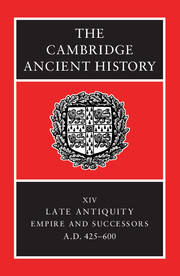Book contents
- Frontmatter
- PART I CHRONOLOGICAL OVERVIEW
- PART II GOVERNMENT AND INSTITUTIONS
- 6 Emperor and court
- 7 Government and administration
- 8 Administration and politics in the cities of the fifth to the mid seventh century: 425–640
- 9 Roman law
- 10 Law in the western kingdoms between the fifth and the seventh century
- 11 The army, c. 420–602
- PART III EAST AND WEST: ECONOMY AND SOCIETY
- PART IV THE PROVINCES AND THE NON-ROMAN WORLD
- PART V RELIGION AND CULTURE
- Conclusion
- Chronological Table
- BIBLIOGRAPHY
- Index
- References
8 - Administration and politics in the cities of the fifth to the mid seventh century: 425–640
from PART II - GOVERNMENT AND INSTITUTIONS
Published online by Cambridge University Press: 28 March 2008
- Frontmatter
- PART I CHRONOLOGICAL OVERVIEW
- PART II GOVERNMENT AND INSTITUTIONS
- 6 Emperor and court
- 7 Government and administration
- 8 Administration and politics in the cities of the fifth to the mid seventh century: 425–640
- 9 Roman law
- 10 Law in the western kingdoms between the fifth and the seventh century
- 11 The army, c. 420–602
- PART III EAST AND WEST: ECONOMY AND SOCIETY
- PART IV THE PROVINCES AND THE NON-ROMAN WORLD
- PART V RELIGION AND CULTURE
- Conclusion
- Chronological Table
- BIBLIOGRAPHY
- Index
- References
Summary
EAST AND WEST: COMMON TRENDS
This chapter is concerned with the political evolution of the ancient city – that is, of a political unit comprising an urban core serving as administrative centre of a rural territory – in a period of great change. As the western empire broke up, the relatively uniform environment that had been provided by the imperial administration was replaced by a great variety of conditions. In view of this, it is perhaps surprising that the evolution of cities in different regions continued to a large extent to follow parallel lines and that comparable developments can be observed in the new barbarian kingdoms and in areas which remained under imperial control, regional differences often being a matter of timing rather than substance.
Taking the city of the second century as a standard of comparison, the type survived better in the east than in the west, but not uniformly well even there. The classical city with an urban population, monumental buildings, games and a highly literate upper class continued in at least the provincial capitals of western and southern Asia Minor, in Syria, Arabia, Palestine and Egypt right up to the Arab invasions, and in the areas under Arab rule even beyond that. In the west the Roman version of the classical ideal survived best in North Africa – but only up to the Vandal conquest – in southern Spain, in Provence and in much of Italy, especially the north.
- Type
- Chapter
- Information
- The Cambridge Ancient History , pp. 207 - 237Publisher: Cambridge University PressPrint publication year: 2001
References
- 1
- Cited by



